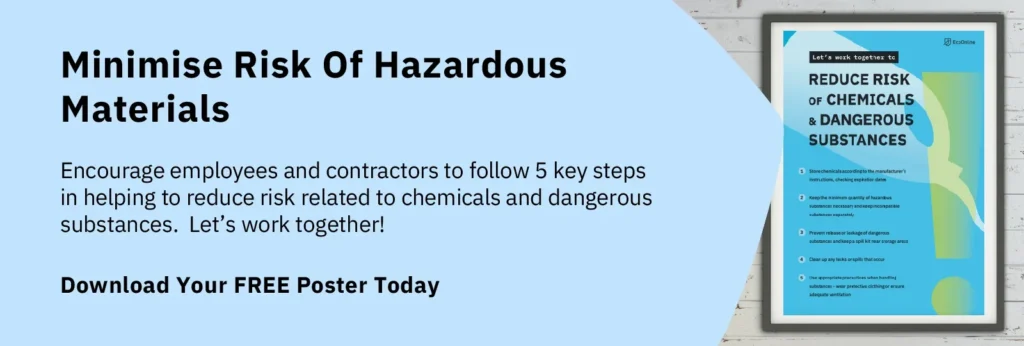
Hazardous Waste Meaning & Definition
What is Hazardous Waste?
Hazardous waste is defined as waste that is hazardous to human health, mainly because it contains toxic chemicals or substances that are released from hospitals, industries, and from households. The waste materials can have different properties, such as:
- Corrosive
- Inflammable
- Explosive
- Highly reactive
- Radioactive
Because these waste materials pose harm to humans and to the environment, it’s important that hazardous waste is disposed of in a safe and secure manner.

The Importance of Safely Disposing Hazardous Waste
Hazardous waste must be disposed of in a proper manner depending upon the risks that it poses. For instance, certain types of radioactive waste cannot be exposed to the environment. It’s generally packed in containers to limit radioactivity, and is mostly buried under the ground.
On the other hand, certain types of hazardous waste materials require special handling. For instance, harmful, corrosive chemicals must be transported in barrels, and workers are often required to wear PPE such as masks to avoid inhaling noxious gases.
The importance of safely disposing hazardous waste is significant due to various reasons. For starters, if waste is not disposed of in a proper manner, there is a strong chance that it could harm the environment.
More importantly, governments and regulatory bodies have strict guidelines about how to dispose hazardous waste. If companies do not adhere to these guidelines, there is a risk of being heavily fined. Over the years, many governments across the globe have started penalising companies that do not dispose hazardous waste properly.

Types of Hazardous Waste
Hazardous waste generally varies in terms of its composition and properties. In most cases, hazardous waste can be categorized into four main classes. These classes or categories differ based on the methods of disposal used, and the risks associated with each.
If hazardous waste is not properly treated or managed, there is a chance that it could cause serious harm to the environment. The four classes or types of hazardous waste are listed below.
Listed Waste
Listed waste generally include waste materials that are created during manufacturing or industrial processes. These are further divided into two lists: the F-List and the K-List. Other lists include the K-List, P-List, and the U-List.
In general, F-List waste materials include:
- Solvents
- Sludge
- Chemical pesticides
- Wood-preserving waste
- Waste released due to metal fishing
- Pharmaceutical waste, including chemicals such as methanol and acetone.
K-List waste materials are specifically released due to industrial processes. They include:
- Waste released due to the production and processing of metals like aluminium, steel, and iron.
- Waste products released during veterinary processes.
- Lead wastage
- Waste products released during the refining of petroleum or other products, including several derived from crude oil.
- Both organic and inorganic chemical waste.
Universal Waste
Universal waste is a broad classification of hazardous waste materials that include many different items, including bulbs, equipment or items that contain mercury, batteries, or different types of pesticides. These are also known as “dangerous goods.”
Universal waste can be categorized into one of 9 classes:
- Explosives
- Gases
- Flammable Liquids
- Flammable solids or substances
- Oxidizing substances or inorganic peroxides
- Toxic and infectious substances
- Radioactive materials
- Corrosive substances
- Miscellaneous dangerous substances and articles
Mixed Waste
This is waste that contains radioactive as well as hazardous components. Since they are so dangerous, it’s important that a customized treatment method is used for their disposal.
Mixed wastes can either be:
- Low-level mixed waste
- High-level mixed waste
- Mixed transuranic waste
Companies must adhere to specific disposal methods depending upon the type of waste they release as a result of production processes. It’s also important for organizations to take appropriate steps to reduce the hazard levels of the waste.
Characteristic Waste
In contrast with listed wastes, characteristic waste materials are identified based on the attributes or characteristics that they exhibit. They can be categorized into four different characteristics.
1. Ignitability
This includes any waste materials that are flammable and can result in a fire.
2. Corrosivity
Corrosive waste goods, which include materials that can rust or decompose, or melt steel, fall into this category. Aqueous waste materials, including both acids and bases, fall into this category.
3. Reactivity
Reactive goods are generally volatile and unstable in normal conditions. If they aren’t treated properly, they can cause an explosion, and thus, they pose a major risk to the environment.
4. Toxicity
Waste materials that can prove to be poisonous if ingested are classified within this category. For instance, lithium-sulphur batteries are incredibly toxic, and can result in death if ingested.
Effective Waste Management Is Necessary to Dispose of Hazardous Goods
Dangerous goods and hazardous waste must be disposed in a proper manner. In some cases, the hazardous waste must be transported to a specific facility under very particular conditions to isolate it from humans and the environment.
In other situations, companies must reduce the hazardous levels of the waste goods through different processes before disposing of the waste. Without effective waste management policies, it’s impossible for organizations to properly dispose of hazardous goods.
Mitigate Risks Associated with Handling Hazardous Waste with EcoOnline
EcoOnline’s Health & Safety software allows companies to easily prepare a list of all hazards and risks associated with handling and managing hazardous waste. They can use this information to prepare safety plans and take appropriate steps to mitigate the health hazards and risks associated with handling hazardous waste.



